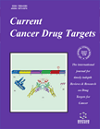- Home
- A-Z Publications
- Current Cancer Drug Targets
- Previous Issues
- Volume 13, Issue 4, 2013
Current Cancer Drug Targets - Volume 13, Issue 4, 2013
Volume 13, Issue 4, 2013
-
-
Aberrant Splicing, Hyaluronan Synthases and Intracellular Hyaluronan as Drivers of Oncogenesis and Potential Drug Targets
More LessAuthors: Sophia Adamia, Patrick M. Pilarski, Andrew R. Belch and Linda M. PilarskiCurrent evidence suggests a significant role of aberrant splicing in the development and maintenance of malignancy. This multistep, tightly regulated epigenetic process leads to the production of abnormal proteins with abnormal functions contributing to underlying mechanisms of malignant transformation. Splicing patterns in malignant cells can be altered not only by the mutations detected on the aberrantly splice Read More
-
-
-
Nanomedicines as Cancer Therapeutics: Current Status
More LessAs of 21st century, cancer is arguably the most complex and challenging disease known to mankind and an inevitable public health concern of this millennium. Nanotechnology, suitably amalgamated with cancer research, has ushered an era of highly personalized and safer medicines which can improve cancer diagnosis and therapy. A wide variety of nanomedicines are currently under investigation, including polymeric/non-p Read More
-
-
-
DNA Methyltransferase-1 Inhibitors as Epigenetic Therapy for Cancer
More LessAuthors: Varinder Singh, Prince Sharma and Neena CapalashDNA methylation is an epigenetic modification involved in gene expression regulation. In cancer, the DNA methylation pattern becomes aberrant, causing an array of tumor suppressor genes to undergo promoter hypermethylation and become transcriptionally silent. Reexpression of methylation silenced tumor suppressor genes by inhibiting the DNA methyltransferases (DNMT1, DNMT3A, and DNMT3B) has emerged a Read More
-
-
-
Therapeutic Perspectives on Pancreatic Cancer
More LessAuthors: Anjali V. Sheahan, Phoebe A. Phillips and Levon M. KhachigianPancreatic cancer has a poor prognosis, with only 10% survival one year following diagnosis. Despite significant advances in conventional therapies (chemotherapy and radiotherapy), little improvement in patient survival has occurred in the last decade. Therefore, there is a critical need for novel and effective therapeutic approaches for this cancer. This article reviews current concepts in the pathogenesis and treatment of p Read More
-
-
-
The Histone Deacetylase Inhibitor, MS-275 (Entinostat), Downregulates c-FLIP, Sensitizes Osteosarcoma Cells to FasL, and Induces the Regression of Osteosarcoma Lung Metastases
More LessAuthors: Krithi Rao-Bindal, Nadezhda V. Koshkina, John Stewart and Eugenie S. KleinermanThe purpose of this study was to determine the effects of the histone deacetylase inhibitor, MS-275, on the Fas signaling pathway and susceptibility of osteosarcoma (OS) to Fas ligand (FasL)-induced cell death. OS metastasizes almost exclusively to the lungs. We have shown that Fas expression in OS cells is inversely correlated with their metastatic potential. Fas+ cells are rapidly eliminated when they enter the lungs via interacti Read More
-
-
-
VEGF in Tumor Progression and Targeted Therapy
More LessAuthors: Vladimir P. Chekhonin, Sergey A. Shein, Anna A. Korchagina and Olga I. GurinaProgression of solid tumors depends on vascularization and angiogenesis in a malignant tissue. Among a whole range of proangiogenic factors, a vascular endothelial growth factor A (VEGF-A) plays a key role. Blockade of VEGF may lead to regression of vascular network and inhibition of a tumor growth. In the present time, bevacizumab has been introduced into wide clinical practice in therapy of breast cancer, colorectal c Read More
-
-
-
Castration-resistant Prostate Cancer: Novel Therapeutics Pre- or Post- Taxane Administration
More LessAuthors: Masaki Shiota, Akira Yokomizo, Naohiro Fujimoto, Hidetoshi Kuruma and Seiji NaitoUntil 2010 docetaxel was the only agent with a proven survival benefit in the treatment of castration-resistant prostate cancer (CRPC). Recent evidence suggests that CRPC is caused by augmented androgen/androgen receptor (AR) signaling involving AR hypersensitivity, promiscuous activation of the AR, de novo production of androgens and activation of the AR by cytokines and growth factors; these findings have led Read More
-
-
-
Combined Treatment with PPAR-γ Agonists in Pancreatic Cancer: A Glimmer of Hope for Cancer Therapy?
More LessPancreas cancer is the fourth leading cause of cancer death due to the limited treatment success rate. The wide number of signalling pathway aberrations contributing to tumorigenesis, progression and drug resistance, is the main reason for unsuccessful treatments in pancreatic cancer. An additional and still under-investigated intracellular cancer target is the peroxisome proliferator activated receptor gamma (PPAR-γ). S Read More
-
-
-
Valeriana jatamansi Constituent IVHD-valtrate As a Novel Therapeutic Agent to Human Ovarian Cancer: in vitro and in vivo Activities and Mechanisms
More LessAuthors: Xiaoguang Li, Tao Chen, Sheng Lin, Jing Zhao, Peizhan Chen, Qian Ba, He Guo, Yanling Liu, Jingquan Li, Ruiai Chu, Lei Shan, Weidong Zhang and Hui WangIdentification of novel chemotherapeutic agents from traditional medicines and elucidation of the molecular basis of their anticancer effects are critical and urgently needed for modern pharmacotherapy. We previously found that analogs of the compounds present in Valeriana jatamansi, a traditional medicine used to treat mental disorders, possess notable antitumor properties; however, the underlying molecular mechanis Read More
-
Volumes & issues
-
Volume 25 (2025)
-
Volume 24 (2024)
-
Volume 23 (2023)
-
Volume 22 (2022)
-
Volume 21 (2021)
-
Volume 20 (2020)
-
Volume 19 (2019)
-
Volume 18 (2018)
-
Volume 17 (2017)
-
Volume 16 (2016)
-
Volume 15 (2015)
-
Volume 14 (2014)
-
Volume 13 (2013)
-
Volume 12 (2012)
-
Volume 11 (2011)
-
Volume 10 (2010)
-
Volume 9 (2009)
-
Volume 8 (2008)
-
Volume 7 (2007)
-
Volume 6 (2006)
-
Volume 5 (2005)
-
Volume 4 (2004)
-
Volume 3 (2003)
-
Volume 2 (2002)
-
Volume 1 (2001)
Most Read This Month
Article
content/journals/ccdt
Journal
10
5
false
en


